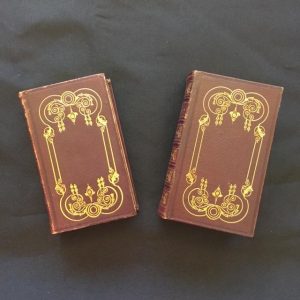For my two Bibles, I chose a pair of books the Loyola Notre Dame Library has acquired. One is a King James Bible, while the other is a personal prayer book. They are essentially identical – both are about 6” by 4”, with a deep brown leather cover, covered in a gilded scroll pattern. There are floral patterns on the spines of the books. The paper used for both books is coarse and white; the Bible has about 400 pages, while the Prayer Book contains around 200 pages. There are fore edge paintings on both books. These are faded, but appear to be depicting some sort of landscape scene.

Both books were published in Oxford in 1842 by a man named John Collingwood for Oxford University, and are printed in English. The Bible includes a letter to King James as a supplementary text, and the Prayer Book contains a religious calendar with holidays and feast days listed. In both texts, there is a handwritten note somewhere on the first few pages. The message is identical in both the Bible and the prayer book, reading: “Henry James Lee Warner. A wedding present from his sisters Anne and Mary. October 8th, 1846.” Other than the personal note on the flyleaves on the two books, there are no annotations, personal markings, or anything of the sort in these texts. They relatively well-preserved. I wonder how frequently these were actually used, considering their age and the quality they are still in.
At the start of this process, there are a few questions and issues I look forward to exploring. First, I am very interested in looking further into the provenance of these books. The handwritten inscriptions on the flyleaves of this pair are a perfect (and obvious) place to start, but it would be a good exercise to try and trace the later owners of these books, before the LNDL acquired them. Did Warner pass these texts along to another Warner family member? Did they somehow find their way into another lineage before landing in Baltimore?
Secondly, I find the relationship between the Bible and the Book of Prayers to be very intriguing. I am not very familiar with prayer books, so I hope to explore how common they were, their use, and whether or not they were always paired with a traditional Bible, especially when given as gifts. This could provide insight into how these texts were truly used in the home, whether they were seen as editions meant to be examined daily, or merely holy objects intended to be kept on the shelf, but rarely touched. How can we understand these books both the way they were in the 19th century, but also as scholars today? I hope to gain an appreciation for these two texts from the standpoint of those who once owned them, fully comprehending how the books were (or were not) a part of daily life.
I look forward to gaining a deep understanding of these texts and their relationship to one another over the next several weeks. After learning about the introduction of printing and the mass production of Bibles and religious texts, it is fascinating to try and grasp these books’ role in society in 1842.